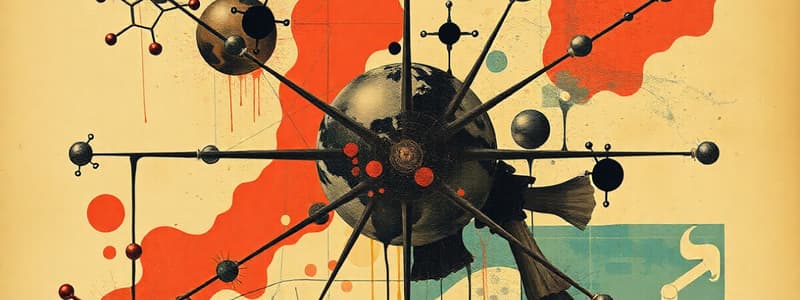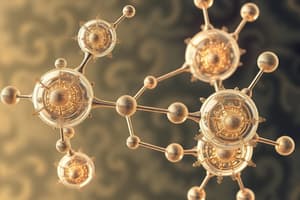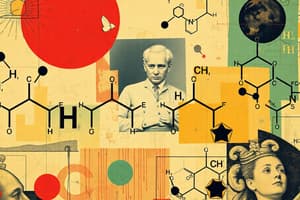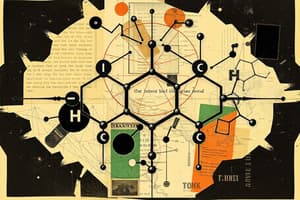Podcast
Questions and Answers
What is the angle between two sp hybrid orbitals?
What is the angle between two sp hybrid orbitals?
- $180^{\circ}$ (correct)
- $109.5^{\circ}$
- $90^{\circ}$
- $120^{\circ}$
Which shape is associated with $sp^2$ hybridization?
Which shape is associated with $sp^2$ hybridization?
- Trigonal (correct)
- Bent
- Tetrahedral
- Linear
Which type of bond is formed by the head overlap of two sp-hybrid orbitals?
Which type of bond is formed by the head overlap of two sp-hybrid orbitals?
- Pi bond
- Hydrogen bond
- Sigma bond (correct)
- Ionic bond
What type of geometry is associated with carbon when it has four single bonds?
What type of geometry is associated with carbon when it has four single bonds?
Which model visually represents the space occupied by atoms in a molecule?
Which model visually represents the space occupied by atoms in a molecule?
Which color in an electrostatic potential map indicates greater electron density?
Which color in an electrostatic potential map indicates greater electron density?
Which of the following is NOT a type of nonbonding intermolecular interaction?
Which of the following is NOT a type of nonbonding intermolecular interaction?
What is the atomic number of an element equal to?
What is the atomic number of an element equal to?
Which of the following best describes an acyclic compound?
Which of the following best describes an acyclic compound?
What is a key characteristic of heterocyclic compounds?
What is a key characteristic of heterocyclic compounds?
What is the maximum number of electrons an orbital can hold?
What is the maximum number of electrons an orbital can hold?
What is the term for groups of atoms that impart specific chemical properties to an organic molecule?
What is the term for groups of atoms that impart specific chemical properties to an organic molecule?
What kind of attraction do ionic compounds use to form bonds?
What kind of attraction do ionic compounds use to form bonds?
What happens during the formation of an ionic bond?
What happens during the formation of an ionic bond?
What type of bond is formed by the lateral overlap of two atomic orbitals?
What type of bond is formed by the lateral overlap of two atomic orbitals?
What is a molecule?
What is a molecule?
What determines bond polarity?
What determines bond polarity?
What is the process of mixing atomic orbitals to create new hybrid orbitals called?
What is the process of mixing atomic orbitals to create new hybrid orbitals called?
In a nonpolar covalent bond, how are electrons shared?
In a nonpolar covalent bond, how are electrons shared?
Which orbitals are typically involved in hybridization?
Which orbitals are typically involved in hybridization?
What shape is associated with sp³ hybridization?
What shape is associated with sp³ hybridization?
How many orbitals participate in sp² hybridization?
How many orbitals participate in sp² hybridization?
What is the approximate angle between bonds in a molecule with sp3 hybridization?
What is the approximate angle between bonds in a molecule with sp3 hybridization?
Hybrid orbitals form what type of bonds?
Hybrid orbitals form what type of bonds?
Methane (CH4) is formed by overlap of four sp3 carbon orbitals with which orbitals of hydrogen atoms?
Methane (CH4) is formed by overlap of four sp3 carbon orbitals with which orbitals of hydrogen atoms?
Flashcards
Ionic Bond
Ionic Bond
Electrostatic attraction between positively charged cations and negatively charged anions.
Formation of Ionic Bonds
Formation of Ionic Bonds
Formed by the complete transfer of valence electrons from an electropositive atom to an electronegative atom.
Covalent Bond
Covalent Bond
Sharing of one or more electron pairs between two atoms.
Bond Polarity
Bond Polarity
Signup and view all the flashcards
Double Bond
Double Bond
Signup and view all the flashcards
Organic Compound Classes
Organic Compound Classes
Signup and view all the flashcards
Acyclic Compounds
Acyclic Compounds
Signup and view all the flashcards
Carbocyclic Compounds
Carbocyclic Compounds
Signup and view all the flashcards
Heterocyclic Compounds
Heterocyclic Compounds
Signup and view all the flashcards
Atomic Nucleus
Atomic Nucleus
Signup and view all the flashcards
Pi Bond (π)
Pi Bond (π)
Signup and view all the flashcards
Hybridization
Hybridization
Signup and view all the flashcards
Orbital Mixing
Orbital Mixing
Signup and view all the flashcards
Hybrid Orbital Use
Hybrid Orbital Use
Signup and view all the flashcards
sp³ Hybridization
sp³ Hybridization
Signup and view all the flashcards
sp² Hybridization
sp² Hybridization
Signup and view all the flashcards
sp Hybridization
sp Hybridization
Signup and view all the flashcards
Methane (CH4)
Methane (CH4)
Signup and view all the flashcards
Excited State
Excited State
Signup and view all the flashcards
Hybridization State
Hybridization State
Signup and view all the flashcards
Triple Bond (sp)
Triple Bond (sp)
Signup and view all the flashcards
Bond Angles & Hybridization
Bond Angles & Hybridization
Signup and view all the flashcards
Electrostatic Potential Map
Electrostatic Potential Map
Signup and view all the flashcards
Nonbonding Intermolecular Interactions
Nonbonding Intermolecular Interactions
Signup and view all the flashcards
Study Notes
- Pharmaceutical Organic Chemistry is the study of carbon compounds.
- Taibah University's class attendance and attendance recording is mandatory.
- 75% attendance is required to take the final exam.
- Attendance will be recorded 10 minutes after class or lab starts.
- Students missing a class, lab, quiz, or exam must file a petition to the Vice-Dean for Academic Affairs for a possible make-up.
Assessment, Evaluation, and Grading Breakdown:
- Quizzes and homework every two weeks account for 5% of the final grade.
- Essay/Report/Lab performance/Practical test accounts for 5% of the final grade.
- Written Test (1) accounts for 15% of the final grade and will be in week(s) 5 and 6.
- Written Test (2) accounts for 15% of the final grade and will be in week(s) 11 and 12.
- The practical final exam accounts for 20%.
- Final Exam (theoretical) accounts for 40% of the final grade and will be during Week(s) 18 and 19.
Course Objectives
- Explain the molecular properties of organic compounds.
- Describe organic compounds' nomenclature (IUPAC and common) and drawing structure.
- Clarify the principal aspects of stereochemistry in organic reactions and their mechanisms.
- Identify practically organic compounds.
- Define the fundamentals of organic chemistry required for related courses in the Pharmacy curriculum.
What is Organic Chemistry?
- A subject that studies structures, properties, and reactions of organic compounds and materials containing carbon atoms.
- Organic compounds also contain hydrocarbons or carbon bonded to hydrogen (C-H).
- Organic compounds can be obtained from living organisms or through synthesis.
Classification of Organic Compounds According to Molecular Framework:
- Organic compounds can be classified into acyclic, carbocyclic, and heterocyclic compounds.
- Acyclic compounds have chains of carbon atoms without rings.
- Carbocyclic compounds contain rings of carbon atoms with a minimum of three carbon atoms.
- Heterocyclic compounds have at least one atom in the ring is a heteroatom (not carbon), commonly oxygen, nitrogen, or sulfur.
- Functional groups are groups of atoms that dictate the chemical properties of a molecule.
- The hydroxyl group (-OH) is the functional group of alcohols.
Atomic Structure:
- Atoms consist of a dense nucleus of positively charged protons and neutral neutrons surrounded by negatively charged electrons.
- The atomic number is the count of protons in the nucleus.
- Atomic weight is the sum of protons and neutrons in the nucleus.
Electron Arrangement
- Electrons are arranged in orbitals (s, p, d, f).
- Each orbital can hold two electrons.
- Orbitals form shells (numbered 1, 2, 3, etc.).
- Valence electrons are in the outermost shell.
- The kernel includes the nucleus and inner electrons.
- Valence determines the number of bonds an element can form.
- The number of electrons to fill valence shells corresponds to Valence.
The Octet Rule:
- Some atoms react to achieve stable arrangements.
- Elements gain or lose electrons to achieve noble gas configuration.
- Atoms transfer or share electrons to reach a filled electron shell, called an octet.
- Atoms will gain or lose electrons in such a way that filled shell of electrons.
Electronegativity (EN):
- The measure of an atom's ability to attract electrons.
- Electronegativity increases from left to right and bottom to top on the periodic table.
- An EN difference less than 0.5 results in nonpolar covalent bonds.
- A difference between 0.5 and 1.9 results in polar covalent bonds.
- A ditference of 2.0 or above results in Ionic bonds.
- Shared electrons are more attracted to atoms with higher electronegativity.
Ionic Bonds:
- Formed by the electrostatic attraction between positively charged cations and negatively charged anions.
- Complete transfer of valence electrons from an electropositive atom to an electronegative atom.
- Electropositive atoms give up electron to form cations.
- Electronegative atoms accept electrons to form anions.
Covalent Bonds
- Results from the sharing of electrons between atoms.
Bond Polarity
- A useful concept to describe the sharing of electrons between atoms.
- Bond polarity arises from electronegativity differences.
- Atoms with more carbon tend to have partial negative charges, while atoms such as hydrogen tent to be neutral with a partial positive charge.
- Equal sharing leads to nonpolar covalent bonds; unequal sharing leads to polar covalent bonds.
- Bond polarity is quantized by dipole moment (μ), measured in Debyes (D).
- Dipole moment measures bond polarity.
- Nonpolar covalent bonds share electrons equally.
- Polar covalent bonds have electrons attracted more strongly, creating partially charged atoms.
- Bond polarization is indicated by an arrow pointing to the negative with a plus sign.
- Double bond, refers to multiple covalent bonds refers to the atoms share electrons.
- Atoms share more than one pair.
Types of Covalent Bonds:
- Double bonds share two electron pairs.
- Triple bonds share three electron pairs.
- Nonbinding electrons are unshared pairs of electron reside on one atom.
- Coordinate covalent bonds form when one atom supplies both electrons to another.
Carbon-Carbon Single Bonds
- They can form between carbon atoms.
Catenation
- The term referring to the ability of carbon atoms to other carbon atoms.
- Breaking a carbon-carbon bond yields methyl radicals, which are very reactive due to unpaired electrons.
- Less heat is needed to break the carbon-carbon bond, which is longer than the H-H bond.
- Bond energy is inversely proportional to bond length.
The Orbital View of Bonding
- Atomic orbitals (s, p, d, f) have define shapes.
- Two atoms approach each other for their orbitals to overlap
- A molecular orbital includes the space occupied by the electrons in the molecule and contains no more than two electrons.
- Sigma (σ) bonds may also be formed head-to-head overlapping of two atomic orbitals
- Pi bonds created when correctly aligned p orbitals can overlap
Hybridization
- It's the concept of mixing 2 atomic orbital to give rise to a new hybridized orbitals.
- Essential for understanding bonding and molecular geometry.
- Hybrid orbitals are made from merging two 's' orbitals or two or mixing of an 's' orbital with a 'd' orbital, they involve equal energies,
Types of Hybridization:
- sp³ hybridization results in a tetrahedral geometry. 4 (1s + 3p) .
- sp² hybridization results in a trigonal planar geometry. 3 (1s + 2p).
- sp hybridization features a linear geometry.2 (1s + 1p).
Carbon Hybridization
- Carbon can form bonds by overlapping of any hybrid and nonhybridized atoms to form ionic compounds.
- In Methyl there is a sp³ hybridization with 109.5 degree angle
- In Ethene there is a sp² hybridization with 120 degree angle
- In Ethyne there is a sp Hybridization with 180 degree angle
Molecular Geometry Depictions
- Carbon can be represented in various structural forms such as slid lines, Ball-and-Stick and Space-filling
- Geometry of carbon is commonly represented as with slid lines showing the atoms or elements in C-H.
- Ball and stick model is showing bonds that connect the atoms for instance represent by the stick.
- Space filling will show the space occupied by the atom.
- Electrostatic potential map will define the molecules whether an electron distribution with a red indicating the negative partial charge, while blue indicates positive partial charge.
Intermolecular Interactions
- Physical properties are determined by intermolecular forces.
- Attraction between molecules without forming bonds.
- Interactions increase with increasing weight and polarity.
- Intermolecular forces are weaker than intramolecular ones.
- Types of Interactions: Dipole-dipole interactions, Van der Waals forces, Hydrogen bonding.
Dipole-Dipole Interactions:
- Between the negative end of one dipole and the positive end of another.
- Polar molecules are held together strongly, and therefore these dipole-dipole interactions.
Nonbonding Van Der Waal's Forces:
- A general terms sued to define attraction of intermolecular forces between molecules and weak interactions.
- Exists between nonpolar molecule that at one point has electron move continuously within bonds and molecule.
Hydrogen Bonding
- A strong kind of attraction between dipole atoms bonded to an electronegative atom.
- Atoms such as atoms covalent bonded with oxygen, fluorine or hydrogen produce this bonding.
Isomerism:
- The same number and kinds of atoms will have different arrangements and formula, this is known as the term of formula that tell the atoms those molecule.
Structural Isomers:
- Have same molecular formula and different arrangement of atoms in their formula.
- Use continuous chain or branch when using written structural formula when using the same molecular formula
- There can be formulas which are abbreviated while the main structural formulas are tire some.
- Structures are combined form smaller chains, the structures can be expressed on a signal in the following ways of using lines.
Resonance:
- Represents 2 or more structure with those identity arrangements to atoms while they different electrons.
- To have these structures, the substance will present the structure of resonance.
- They are all arranged to isomer which have these structure between its elements.
- Arrows used and seen the electrons move in actions, is commonly used to indicate structure in resonance with a single half of a head.
Studying That Suits You
Use AI to generate personalized quizzes and flashcards to suit your learning preferences.




